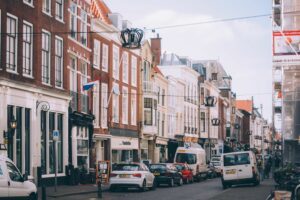Two Peas in a Pod: Digital twins and connected logistics operations
Offline urban logistics operations need to be mirrored online - Digital Twins are helping to deliver the future, say Giacomo Lozzi and Claudia Ribeiro. The LEAD project will create Digital Twins of shared and connected logistics operations in six cities, to support experimentation and decision making in a public-private urban setting.
It’s quite likely that readers of this magazine will have played or at least heard about the life simulation video game The Sims that was incredibly popular in the 2000s. The game, revolutionary at the time, enabled players to create an avatar and move in virtual spaces and dynamics, but also interact with other characters, all virtual representations of real people.
This brief example helps us introduce the concept of the Digital Twin, a 3D digital replica of a complex real-world urban environment that represents different processes, actors and their interaction. This is based on two characteristics: the virtual version of the model reproduces its physical counterpart in a realistic, complex and dynamic way. This linkage is established through the generation of real-time data, using sensors, GIS, and other sources such as dynamic databases. This allows the models to synchronize constantly - making use of elements such as the Internet of Things (IoT), Artificial Intelligence (AI), software analytics and spatial network graphs.
A new dimension for urban planners
Born as a supportive element in the processes of product lifecycle management in manufacturing, Digital Twins have started becoming popular for predictive urban planning. Interactive platforms capture and display the 3D urban environment via real-time data feeding, to improve planning from long-term infrastructure investments to near-real-time service operations.

Madrid, Siarhei Plashchynski
The Digital Twin evolves with the city by bringing in data from a variety of sources and by receiving real-time city data through sensors. Changes within the real-world automatically update the virtual models through online processes. In the field of transport, various initiatives have started popping up, supporting experimentation and decision-making in a public-private urban setting for passengers’ mobility and logistics.
The city of Rotterdam is building its 3D Digital Twin within the Rotterdam Digital City program. The idea is to pull existing digital solutions together, to ensure interoperability and provide a ‘future-proof’ roadmap for the city. The DUET project Digital Twins, taking place in Athens, Flanders, and Pilsen, aims to open and democratise available Smart City data to citizens, companies and service providers for co-creative policymaking. The PAV project considers Digital Twins applications for stimulating the uptake of shared and electric autonomous vehicles by local authorities.
The challenges of dawning on-demand city logistics
One of the most dynamic and evolving sectors of urban transport is logistics. Last mile delivery systems are facing many challenges associated with the dawn of on-demand logistics, struggling to accommodate citizen’s expectations for responsive logistics systems, that deliver products at low or even zero cost. This is the case for both small and large-scale consumer platforms, pledging swift delivery times, albeit with little market economic incentives for the creation of sustainable systems.
This so-called 'Uberisation of logistics’ is putting a strain on cities that are faced with the potential negative consequences of this phenomenon, alongside the unpredictability of market developments. The recent COVID-19 crisis has demonstrated the importance of the resilience of the logistics chain, which sees the most complex stretch in the last urban mile. It is also changing the way citizens buy, increasingly turning to online, on-demand platforms. This pressure on the system must therefore be efficiently mitigated.
Cities are aware of these challenges and have begun addressing them, with an increasing number of Logistics Living Labs, complementing the old ‘predict and provide’ paradigm. A Logistics Living Labs is an ecosystem where all stakeholders, public and private, are involved to co-create, test, assess and adjust of efficient and sustainable solutions on urban logistics1. They provide for the right environment to test, assess and adjust the ZEZ for freight and supporting measures.
Real-time mirroring for shared-connected and low-emission logistics operations
Digital Twins are fairly new concepts in the sphere of urban logistics. The LEAD project will create Digital Twins of urban logistics networks in six cities (Madrid, The Hague, Budapest, Lyon, Oslo and Porto), to test and represent different innovative solutions for shared-connected and low-emission logistics operations and to address the requirements of the on-demand economy while aligning competing interests and creating value for all different stakeholders.
The LEAD project was launched during a two-day online Kick-Off Meeting on 8 and 9 June 2020. 27 partners are involved, from nine European countries, the USA, and China, with a complete value chain of actors capable of achieving the project’s objectives, including City and Logistics stakeholders, research organisations and SMEs.

Porto
The Digital Twin for each Logistics Living Lab will work as a virtual ‘living’ equivalent of the intervention area, integrating data sources and allowing the modelling of possible strategies to deal with problems before and as they occur. LEAD has ensured access to the data sources required for the implementation of the action through the city and business partners. Cities will provide demographic and traffic data; real-time data will be collected through ITS infrastructure and urban data platforms available. Citizen data will be collected and anonymised via scenario-based surveys, while operational data (fleet characteristics, vehicle capacity) will be provided by the logistics partners.
The Digital Twin of each Logistics Living Lab will enable the simulation of what-if scenarios and anticipating emergent behaviour in certain events. This will help stakeholders to understand how cities will likely perform under various economic, environmental and social conditions and implement the best possible solutions with established knowledge of the outcomes of the alternative scenarios. Agent-based (ABM) models will be used to enable city logistics stakeholders to recognise their roles and business models, including all relevant operational, tactical and strategic decisions in the Digital Twin, mirroring value cases in the reality of city life.
The final step of this phase will be implementing and demonstrating the optimal solutions for the six cities’ value cases. The long-term vision of LEAD is to design an Open Physical Internet-inspired framework for Smart City Logistics that incorporates the created Digital Twins, laying the foundations for the development of large-scale city Digital Twins.
There are many benefits and implications of introducing Digital Twins as an advanced decision support tool for local authorities to plan and manage pressures caused by on-demand economy, while aligning competing interests and creating value for different stakeholders. Developing this kind of digital city can optimise, enhance and improve cities’ urban planning processes. However, it is technically challenging and raises socio-political issues related to privacy, security, ownership, and governance.

The Hague, Alisa Anton
Cities need to exploit it as a ‘means to an end’, i.e. as a tool to empower and involve citizens, companies and service providers and to integrate the available data for co-creative policymaking. Moreover, Digital Twins should be framed in the broader framework of city strategies and targets, so that actions are aligned and follow each step of the Sustainable Urban Mobility and Logistics Plans cycle.
The sustainable vision of the city should remain as the key driver and motivating factor, with real debate one of the key elements for its creation. LEAD will be addressing all these aspects. In particular, through the setting up of local Logistics Living Labs, city partners will establish a multi-stakeholder community, involving supply chain actors (Freight Forwarders, Transport Operators, Shippers, Retailers, Shop owners), Public Authorities, Associations and experts in a co-creation process.
About LEAD:LEAD operates under the Research and Innovation Actions funding scheme, as facilitated by Horizon 2020 and the ‘Mobility for Growth programme and it will run until December 2022. This project has received funding from the European Union's Horizon 2020 Research and Innovation Programme under Grant Agreement No 861598
Authors: Giacomo Lozzi is Senior Project Manager – Coordinator Urban Freight at Polis Network GLozzi@polisnetwork.eu Claudia Ribeiro is Project Officer at Polis Network cribeiro@polisnetwork.eu
